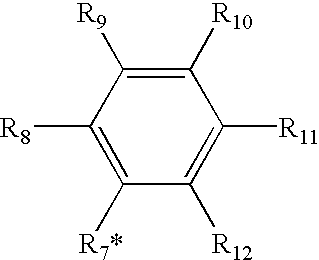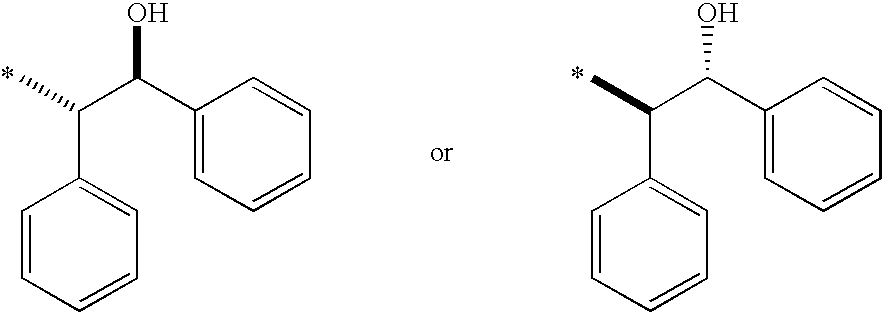Protein kinase and phosphatase inhibitors and methods for designing them
a technology which is applied in the field of protein kinase and phosphatase inhibitors, can solve the problems of serious concern, inability to provide a rational and general solution to obtain non-peptide inhibitors for any desired ptk, and the potential side effects of ptk inhibitor drugs that mimic atp, etc., to achieve the effect of inhibiting protein phosphatase activity, inhibiting protein kina
- Summary
- Abstract
- Description
- Claims
- Application Information
AI Technical Summary
Benefits of technology
Problems solved by technology
Method used
Image
Examples
example 1
Synthesis and Activity of Indole Derivative Protein Kinase and / or Protein Phosphatase Inhibitors
[0141]The following results show the solution phase synthesis of 5-fluoroindole-2-carbaxamide libraries and testing of indole derived protein kinase and / or protein phosphatase inhibitors. These final products are examples of indole-based inhibitors wherein synthesis with a 5-fluoro group is illustrated.
A. Synthesis of Intermediates and Sample Reagents:
[0142]5-fluoro-3-phenylindole-2-carboxylic acid
(a) Preparation of Methyl Ester
[0143]A mixture of 5-fluoroindole-2-carboxylic acid (6 g, 33.5 mmol) and a freshly prepared methanolic HCl (100 mL) was stirred overnight at room temperature. The precipitated ester was collected by filtration, washed with NaHCO3 saturated solution, water, and MeOH. The filtrate was treated with saturated NaHCO3 and extracted with EtOAc. The organic layer was washed with brine, dried (MgSO4), and evaporated in vacuo. The product ester (6 g) was an off white solid...
example 2
Synthesis and Activity of 7-Substituted Indole Derivative Protein Kinase Inhibitors
[0203]7-substituted indole derivative protein kinase inhibitors were synthesized as set forth in Scheme 1, below:
(2-bromo-4-fluoro-phenyl)-hydrazine (2)
[0204]Commercially available 2-bromo-4-fluoroaniline 1 (2.36 ml, 20.75 mmol) was added to a stirring solution of concentrated hydrochloric acid (40 ml) that was cooled to −5° C. This solution was allowed to age while stirring for 10 minutes. An aqueous solution of NaNO2 was added over 15 minutes. SnCl2 / HCl (10.40 g, 46.1 mmol, 10 ml HCl) was added over 15 minutes and aged for an additional 30 minutes to 1 hour. The mixture was filtered and washed with dichloromethane. The resulting solid was dissolved in 1.0M HCl and extracted 3 times with dichloromethane. The organic layer was vacuum dried overnight to give 3.53 g (83% yield). 1H NMR (400 MHz, CDCl3): δ7.169 (dd, J=8 Hz, J=2.8 Hz 1H), δ 7.076 (dd, J=5.2 Hz, J=9.2 Hz, 1H), δ 6.982 (td, J=8.4 Hz, J=2 ...
example 3
Design, Synthesis and Activity of Non-ATP Competitive Hydroxynaphthalene Derivative Inhibitors of pp60c-Src Tyrosine Kinase
[0210]The crystal structure of the autoinhibited human IRTK catalytic domain (Hubbard et al., 1994) was used to carry out qualitative molecular modeling studies (SYBYL™, 6.4, Tripos Inc., St. Louis) wherein a naphthalene ring was superimposed upon the IRTK Tyr 1,162. The IRTK region containing Tyr 1,162 folds back into the active site, with Tyr 1,162 positioned analogous to a phosphorylatable Tyr in a peptide substrate, thereby autoinhibiting the tyrosine kinase. This superimposition indicated that an amide carbonyl should be placed at the 2-position (Scheme 1) of the
naphthalene ring to mimic the Tyr 1,162 carbonyl and a hydroxyl group should be positioned at the 6-position to mimic the Tyr 1,162 hydroxyl group. These modeling studies also indicated that a hydroxyl group at the 3-position could mimic the Tyr 1,162 NH.
[0211]In order to test these design concepts...
PUM
| Property | Measurement | Unit |
|---|---|---|
| PKA | aaaaa | aaaaa |
| temperature | aaaaa | aaaaa |
| temperature | aaaaa | aaaaa |
Abstract
Description
Claims
Application Information
 Login to View More
Login to View More - R&D
- Intellectual Property
- Life Sciences
- Materials
- Tech Scout
- Unparalleled Data Quality
- Higher Quality Content
- 60% Fewer Hallucinations
Browse by: Latest US Patents, China's latest patents, Technical Efficacy Thesaurus, Application Domain, Technology Topic, Popular Technical Reports.
© 2025 PatSnap. All rights reserved.Legal|Privacy policy|Modern Slavery Act Transparency Statement|Sitemap|About US| Contact US: help@patsnap.com



